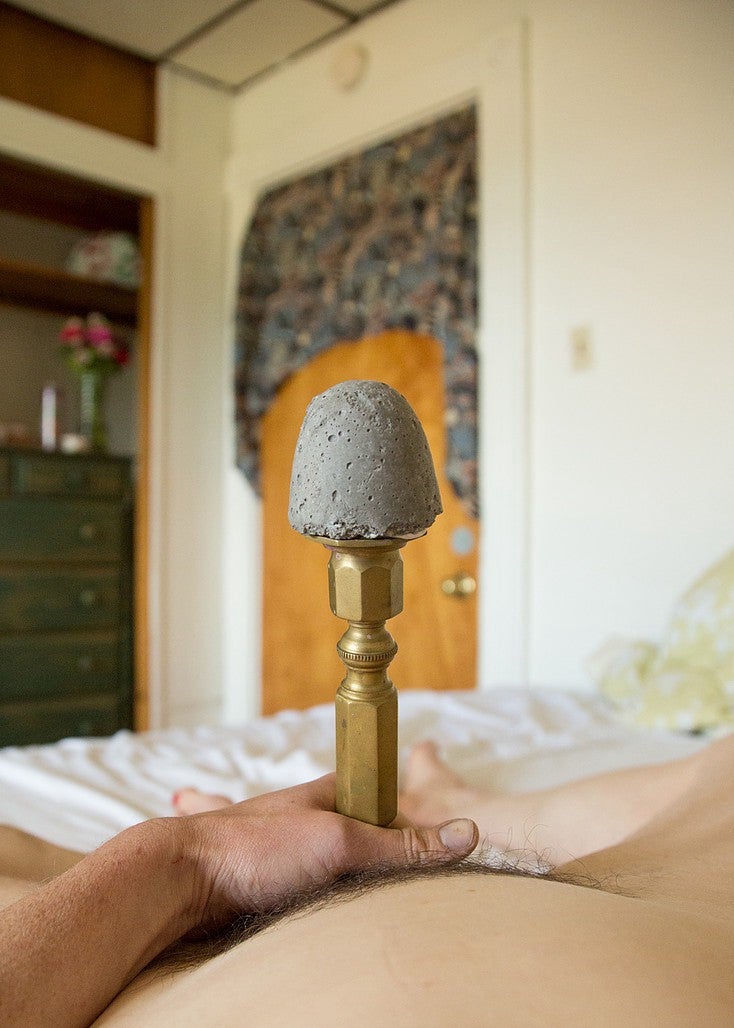Pittsburgh artist Ivette Spradlin, an adjunct professor of photography at Carnegie Mellon, often gives her students “gender swapping” assignments — putting a woman in a man’s place in historical images — to highlight how women and men have been portrayed historically in photographs and paintings (e.g., angles, positioning of bodies, etc.).
One day, she decided to give it a contemporary twist — recreating dick pics with women.
It was also partly in pursuit of an answer to a seemingly impossible question she and her fellow local artist Lenore Thomas had been asking themselves for a couple of years: “How can we get a woman to like a dick pic?”
“We started to talk about desire — specifically men’s idea of desire in relation to what they think women want,” Thomas explains. “We’re certainly interested in the aesthetics as well. The composition and lighting of the photos can be fascinating. Of course, most of the men’s goals is to show a penis and the rest of the image is generally an afterthought.”
The result of their work is “Casual Encounters,” a series of photographs deconstructing the common dick pic using female models and household objects. All selections maintain the original setting and posture but feature topless women clutching various artificial phalluses — a corn cob, a vase with dead flowers, an ice cream cone.
I recently spoke with Spradlin about the unsolicited dick pic, why a makeup sponges makes for a perfect micropenis and how skateboarders in particular seem threatened by their role-reversal imagery.

Where’d you get all your dick pics from?
Craigslist Casual Encounters. We were looking at it from the perspective of heterosexual women looking on Craigslist. We kept a collection of pics on a phone and when the models arrived, we said, “Choose whichever one speaks to you.” We looked for dick pic archetypes, which is how we got our titles: “The Bedroom One”; “The No Sheets On the Bed One”; and “The Office One.”

How close are they to the original?
We really tried to mimic the posture, but it was really difficult.
Why?
Women’s muscles are different than men’s and can’t hold certain positions. Plus, they’re trying to hold an object versus something that’s attached to the body.
Do the objects represent anything about the actual dick in the original picture?
We have a “Bag of Dicks” — a collection of objects we carry with us. Often we find things in our models’ homes. A lot of it is improvised on the spot. There’s one where a woman is wearing an orange sweater using a little makeup sponge. The source image was a man who had a very small penis that he called “The Cocklet.”
Was this project in response to unsolicited dick pics?
We definitely talked a lot with our models about their experiences with that. We’re sensitive to the idea of consent because we’re women and most of us have had negative experiences. That’s also a reason why a friend of mine, who owns a skateboard company called Slapstick Skateboards, used one of our images. A lot of his skateboards have controversial social and political commentary on them. In the 20 years he’s been making boards, he’s never had a problem selling them. Until this board. Shops have refused to carry it.
Has anyone given him a reason why?
The image on the board is taken from [professional skater] Johnny Layton’s dick pic that was sent without consent to a woman. And so, we re-created that dick pic, and it’s caused some controversy. We don’t know if that’s why shops have decided not to carry it. Considering the misogyny within that industry, I think women talking about dick pics immediately makes them think we’re trying to shame men, which is definitely not our intention.
What is your intention?
To question why men send an image of their penis. Then: Can we think beyond what its original intention was? We’re curious about the other implications of the dick pic and where it sits within the history of images. But mostly we want to know: What’s the thought process in creating these?

